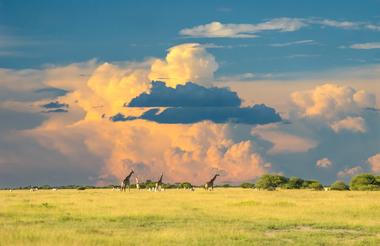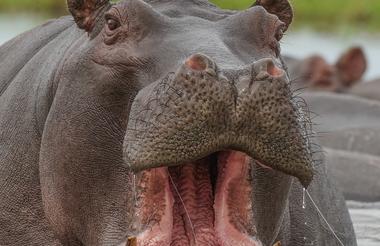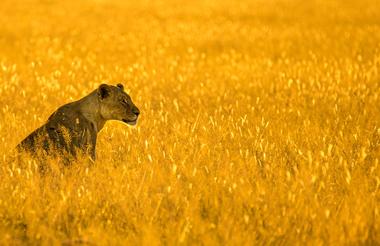The Victoria Falls are one of the natural wonders of the world - the masses of water thunderously plunge into the gorge, creating a spray that forms the so-called rainforest. As the sunlight penetrates, a breathtaking rainbow forms over the falls. Livingstone is situated on the Zambian side, while Victoria Falls, the city named after the falls, is on the Zimbabwean side. Both locations provide access to witness the majestic falls.
GOOD TO KNOW
"The Smoke That Thunders": The powerful curtain of water is known to the locals as Mosi-oa-Tunya, or "The Smoke That Thunders." The Scottish explorer David Livingstone discovered these millions of years old waterfalls in 1855 during one of his journeys to the East Coast of Africa. Traveling south from Luanda to Sesheke, he encountered the picturesque falls and named them after the British monarch, Queen Victoria. Livingstone was guided to the falls by the Makalolo tribe. When Livingstone's reports reached neighboring countries, British traders were the first to journey to the falls. A trading post was established on the riverbank, laying the initial foundations for the present-day city of Victoria Falls, known as Old Drift at that time.
"Dr Livingstone, I presume?": In the 14 years following the discovery of the Victoria Falls, Livingstone struggled with the health consequences of his journey. Isolating himself from the outside world for years raised concerns about his well-being, prompting Henry Stanley to be sent to find him. Stanley reached his destination on November 10, 1871, in an African village, greeting Livingstone with the famous words, "Dr Livingstone, I presume?" This marked the beginning of a close friendship that ended with Stanley's return to England in 1872, without Livingstone. He could not convince Livingstone to return to his homeland. Dr. David Livingstone passed away on May 1, 1873, at the age of 60. In his lifetime, he covered 50,000 km within Africa, making a significant contribution to the exploration of previously unknown regions.
Livingstone: The small town of Livingstone is situated on the Zambian side of the famous Victoria Falls. The town has approximately 15,000 residents, mostly belonging to the Tonga tribe. In the main street, named "Mosi-oa-Tunya Road" after the waterfalls, classic colonial buildings can still be seen, including Victorian houses with tin roofs. The spectacular Victoria Falls and the equally impressive bridge connecting Zambia and Zimbabwe are about 10 km away from Livingstone. From Livingstone, a variety of safari and leisure activities can be booked.
Victoria Falls Bridge: The Victoria Falls Bridge was built in 1905 to connect present-day Zambia and Zimbabwe. Designed by Sir Ralph Freeman, who also planned the bridge in the Sydney Harbor, the steel arch of the bridge spans 156 meters and rises 128 meters above the gorge. It safely carries cars, trains, and pedestrians between the two countries and is also renowned for the breathtaking 111-meter bungee jump (Shearwater Bungee).
World Heritage: The Victoria Falls were recognized as a World Heritage Site in 1989 - one of the most spectacular waterfalls globally. When the Zambezi River is in flood, the falls create the largest curtain of water in the world. The falls and the surrounding rainforest are protected as a 23.4-square-kilometer national park, one of the four World Heritage Sites in Zimbabwe. Booking the "Flight of Angels" is highly recommended, as the falls are even more breathtaking from a bird's-eye view.
Travel Time: The best time to visit is towards the end of the dry season when the water flow is still impressive, but not overwhelming. During peak water levels, the spray can be so dense that the falls are often challenging to see. The lowest water level is in November/December when less than 20,000 cubic meters of water per minute plunge into the gorge. In contrast, the highest water level, with more than 550,000 cubic meters of water per minute, is in February/April. Between April and May, the falls are most spectacular, although it can be difficult to see them along the entire length from the footpath.
For visiting the falls, an entrance fee is charged. Depending on the amount of spray, it is advisable to rent a raincoat or an umbrella to avoid not only wet feet but also to keep your mobile phone and camera dry. The spray provides a welcome cooling effect in the summer, but do not forget to protect your electronic devices.
THINGS TO DO:
At Victoria Falls, a multitude of activities are offered, including boat rides, bungee jumping, safaris, white-water rafting, helicopter tours, and more – catering to every preference.
- Bungee Jumping from one of the world's highest bridges: On the Zambia-Zimbabwe Bridge between the Vic Falls and Livingstone, you have the opportunity to jump 110 meters into the abyss. Another highlight – the bridge also features the world's longest zip line, allowing you to slide from one end of the gorge to the other.
- Interaction with Elephants: "Elephant Encounter" provides guests with the opportunity to spend time in close proximity to these majestic creatures, forming a natural connection with the elephants in a unique way.
- Boat Tours & Sunset Cruises: Enjoy the expanse and tranquility of the Zambezi River with a refreshing drink as the sun sets. A romantic end to an adventurous day.
- Private Helicopter Flight: A flight over the falls is a must-do. Admiring the falls from a bird's-eye view is an unforgettable experience.
THE ZAMBEZI:
The Zambezi, Africa's fourth-longest river at 2,700 km, flows through six countries from Central Africa to the Indian Ocean, forming the spectacular Victoria Falls and the winding Batoka Gorge. Unlike other rivers, its banks are sparsely populated, with some parts designated as nature reserves. The Zambezi River provides energy, sustenance, joy, a transportation route, and a home for diverse flora and fauna along its extensive journey.
OUR RESTAURANT RECOMMENDATIONS:
- Baines Restaurant (www.tripadvisor.co.za/Restaurant-Baines_ Restaurant-Victoria_Falls_Matabeleland_North_Province.html)
- The Lookout Café (www.thelookoutcafe.com)
- MaKuwa-Kuwa Restaurant (www.victoria-falls-safari-lodge.com/ things-to-do/bar-dining/makuwa-kuwa-restaurant/)
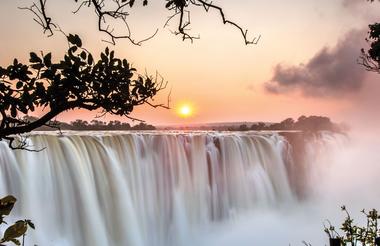
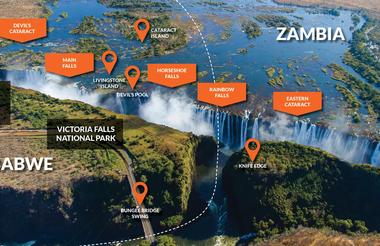
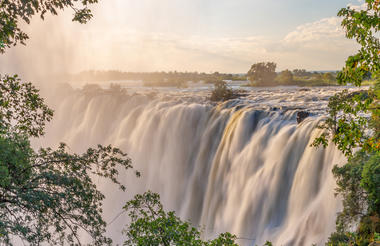
Forming the boundary between Botswana and Namibia is the Chobe River - one of the most well-known perennial rivers in Africa. The Chobe River Front encompasses vast floodplains fringed by lush riverine woodlands. The abundant wildlife inhabiting the river and its shores can be viewed from a river safari where visitors can spot elephants, hippo, water-loving antelope including the rare red lechwe and a variety of other game such as giraffe, zebra, and buffalo. Nature lovers will delight in the incredibly scenic natural landscapes and bird watchers can look forward to the wide section of bird species which can be spotted along the river banks.
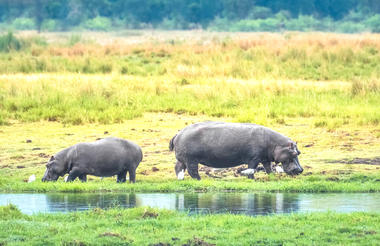
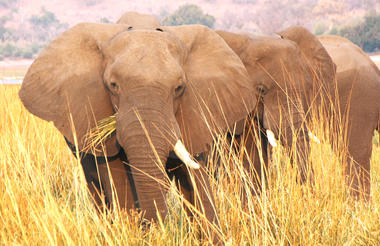
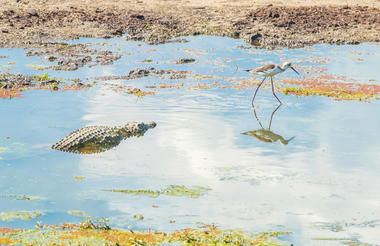
Situated in the east of the Okavango Delta, Moremi Game Reserve ranks as one of the most beautiful reserves in Africa. It covers more than 4871 square kilometres of pristine wilderness, and this varied terrain includes savannah, winding waterways, and dense forest. The diverse ecosystem supports an incredibly wide spectrum of wildlife, ranging from large herds of buffalo, wildebeest and zebra, to the rare sitatunga and lechwe antelope, lion, cheetah and packs of wild dog in the open grasslands. The birdlife is prolific and includes most of the 550 bird species recorded on Botswana’s national bird list. A range of luxury lodges in the reserve offers visitors the perfect base to experience this corner of paradise.
